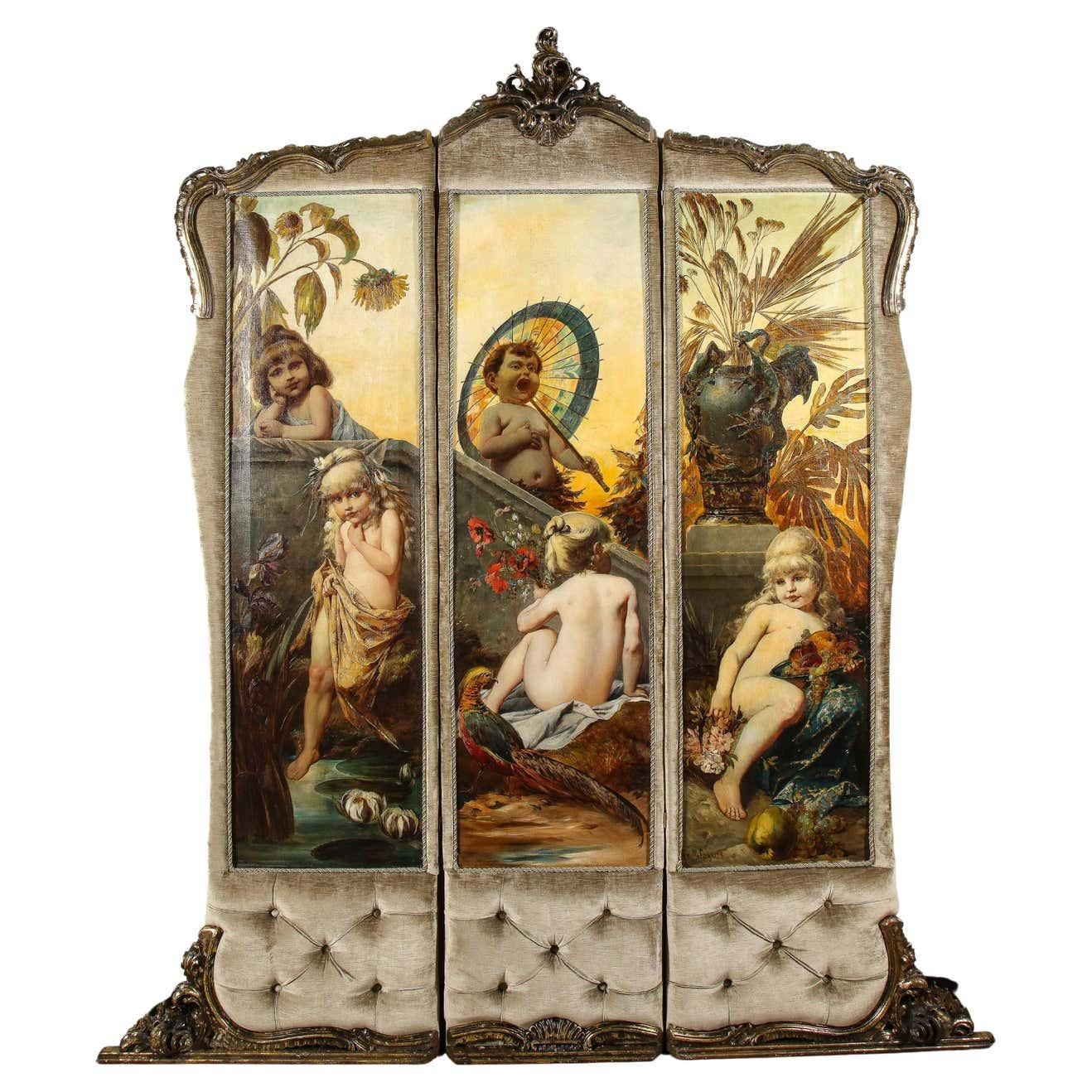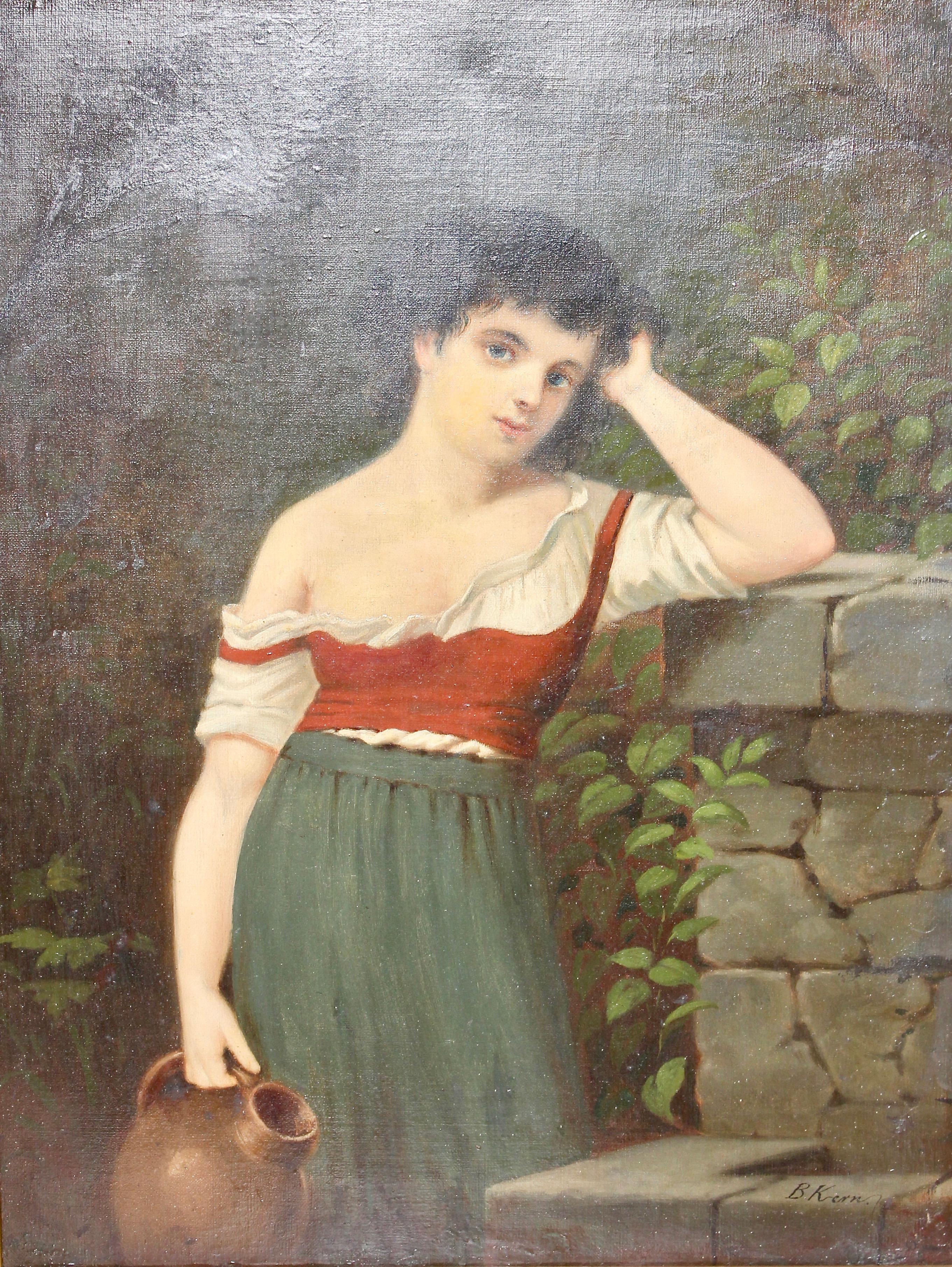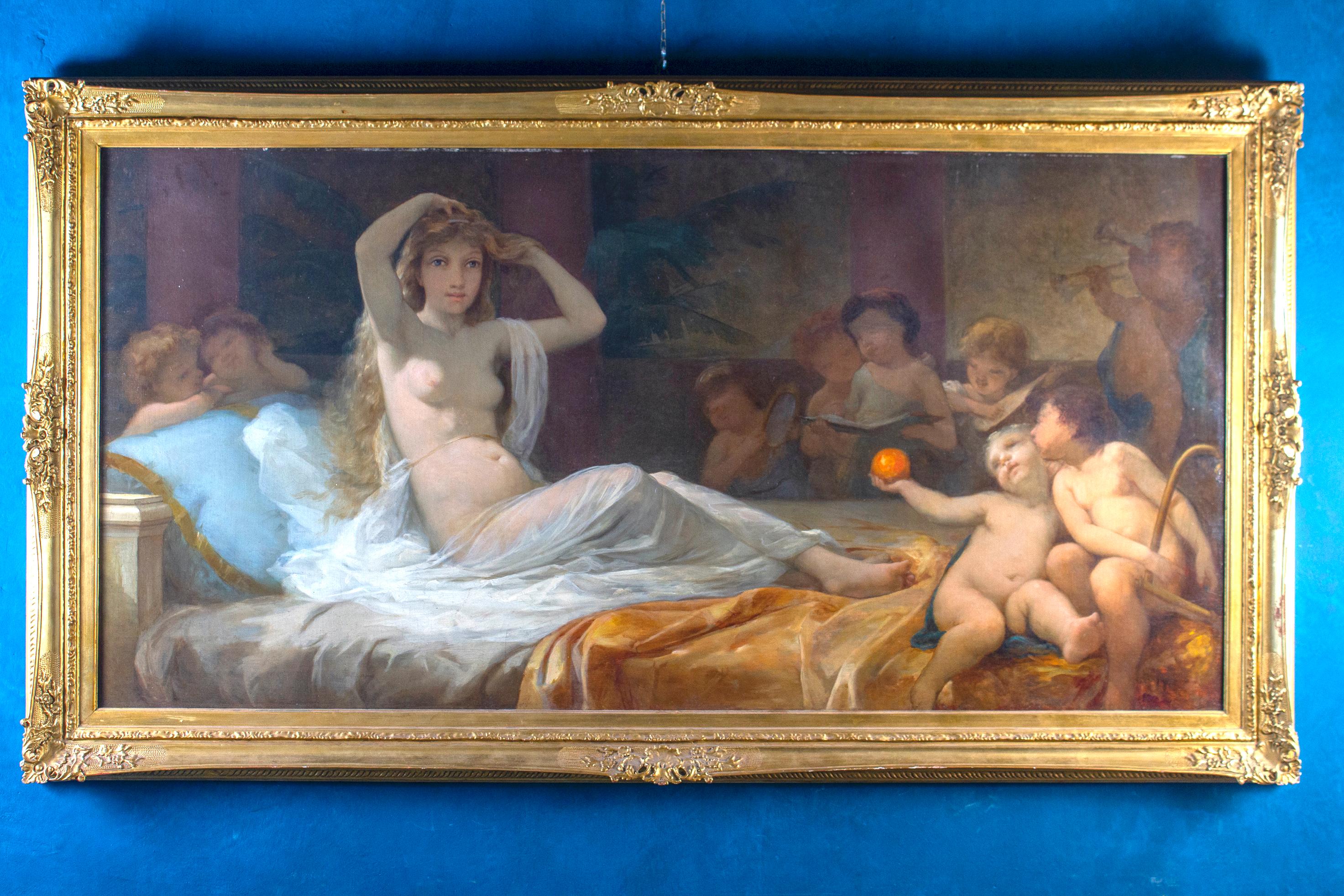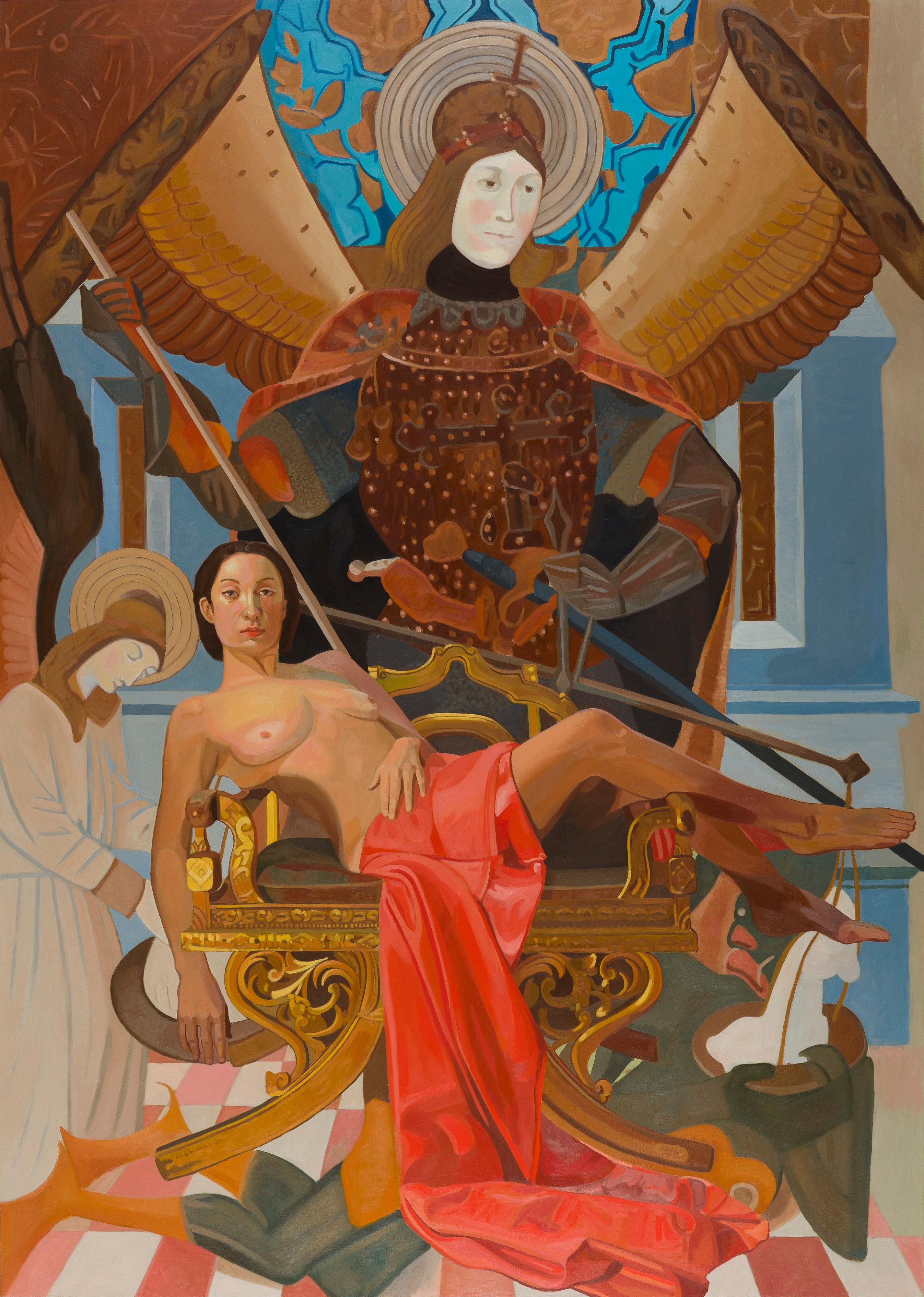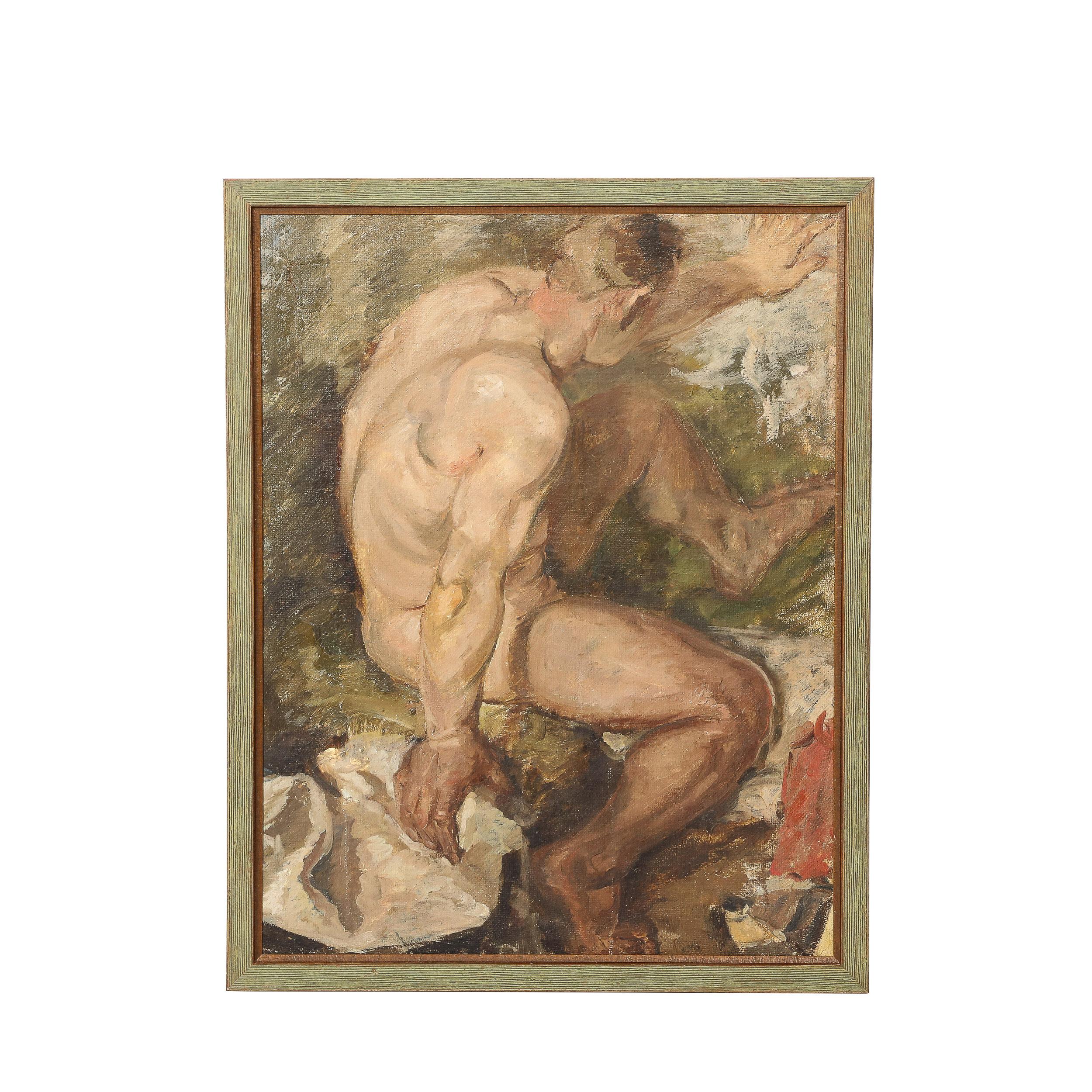Items Similar to J J A Lecomte du Nouÿ (1842-1923) A shoulder and back study, oil painting
Want more images or videos?
Request additional images or videos from the seller
Jean-Jules-Antoine Lecomte du NouÿJ J A Lecomte du Nouÿ (1842-1923) A shoulder and back study, oil painting
About the Item
Jean-Jules-Antoine Lecomte du Nouÿ (1842-1923)
A shoulder and back study, oil study
oil on canvas
34 x 19.5 cm
In good condition, a few small inpaintings visible under UV lights
Stamp of the Estate sale in Toulouse
In a modern frame : 40 x 25 cm
Provenance :
Estate of the artist and family of the artist by descent
Estate sale in Toulouse 22 June 1999
This very interesting oil study was part of a set kept by the artist. He had studied fragments of anatomy both to use them as models in large compositions but probably also because he represented so many fragments.
It is clear that this fragment of anatomy has a power of suggestion and serves as a relay to the imagination of the viewer, who is led to imagine the rest of the body taken as a model. We can speak of metonymy in painting and it is clear that the artist had this in mind when he kept such studies with him.
Jean-Jules-Antoine Lecomte du Nouÿ was born on 10 June 1842 in Paris.
Originally of a Piedmontese origin, his family had been settled in France since the fourteenth century and by the time of his birth had reached the status of nobility
He was an Orientalist French painter and sculptor.
He was strongly influenced by the works and teachings of Charles Gleyre and Jean-Léon Gérôme. Lecomte du Nouÿ found inspiration for his art through extensive travels to Greece, Turkey, Egypt, Romania and Italy.
The thematic content of Lecomte du Nouÿ's work was mainly figural, but also spanned over a vast range of imagery throughout his career, including classical, historical and religious.
Lecomte du Nouÿ is known for remaining faithful to his detailed, realistic style throughout the extent of his career, despite the onset of the Impressionist, Fauvist and Constructivist artistic movements during his lifetime. His work is said to have contributed significantly to the establishment of an iconic repertoire representing the Orient in the nineteenth century.A Parisian street was named after him in 1932.
Lecomte du Nouÿ showed a strong attachment to visual art from a young age and was reported to have painted portraits of his father and uncle by the age of 6.
In 1861, at 19 years of age, the artistic talents of young Jean-Jules-Antoine Lecomte du Nouÿ prompted him to become a pupil at the atelier of Swiss artist, Charles Gleyre. Under Gleyre's guidance Jean-Jules-Antoine learned the significance of individualistic style and gained the foundations of creative visual presentation.
Later, Lecomte du Nouy further perfected his knowledge of the artistic form under the mentorship of Jean-Léon Gérôme, who was a renowned painter of the Academicism movement. It was at this time that Jean-Jules-Antoine learned the precision required to depict "la belle nature" —a style of illustration that aims to create the most beautiful representations of the natural form. This later became one of the main techniques employed in Lecomte du Nouÿ's signature artwork.
In 1865, Du Nouÿ accompanied fellow artist, Félix Auguste Clément, on his travels to Cairo, Egypt. It was after this voyage that the young Lecomte du Nouy sought to portray the opulence of the Orient. In later years, he continued his travels, visiting countries like Italy and Greece. Lecomte du Nouy found inspiration in all social, historical and literary facets of foreign culture.
The Orientalist style is largely characterized by its content, but also by its subdued realism and precision allotted towards depicting the human form. The latter is a prominent characteristic of the 19th century methods upheld by the Académie des Beaux-Arts. Du Nouÿ was a prominent figure within the sphere of academic art and thereby adhered to a rule-based artistic style of well-developed skill and formal composition. The artistic composition of his paintings was often complemented by the use of half-light, which added certain dramatic and melancholic qualities to his work. To this day some, like Alan Braddock, consider Du Nouÿ to have been decidedly modern for his time, because his work directly and indirectly broached some of the key issues of his day, albeit from a decidedly conservative perspective: colonialism, international trade, gender, religion, and history. Du Nouÿ spent most of the later years of his life in Romania. There he painted primarily the royal family and their subjects.However, he returned to Paris right before his death on 19 February 1923.
Artworks by Lecomte du Nouy are held by museums such as Cleveland Museum of Art, Dahesh Museum of Art in New York, Worcester Art Museum, Musée d'Orsay in Paris, Musée des Beaux-Arts de Nantes, etc....
- Creator:Jean-Jules-Antoine Lecomte du Nouÿ (1842 - 1923, French)
- Dimensions:Height: 13.39 in (34 cm)Width: 7.68 in (19.5 cm)
- Medium:
- Movement & Style:
- Period:
- Condition:
- Gallery Location:Paris, FR
- Reference Number:
Jean-Jules-Antoine Lecomte du Nouÿ
Jean-Jules-Antoine Lecomte du Nouÿ was born on 10 June 1842 in Paris. Originally of a Piedmontese origin, his family had been settled in France since the fourteenth century and by the time of his birth had reached the status of nobility
He was an Orientalist French painter and sculptor. He was strongly influenced by the works and teachings of Charles Gleyre and Jean-Léon Gérôme. Lecomte du Nouÿ found inspiration for his art through extensive travels to Greece, Turkey, Egypt, Romania and Italy. The thematic content of Lecomte du Nouÿ's work was mainly figural, but also spanned over a vast range of imagery throughout his career, including classical, historical and religious. Lecomte du Nouÿ is known for remaining faithful to his detailed, realistic style throughout the extent of his career, despite the onset of the Impressionist, Fauvist and Constructivist artistic movements during his lifetime. His work is said to have contributed significantly to the establishment of an iconic repertoire representing the Orient in the nineteenth century.A Parisian street was named after him in 1932. Lecomte du Nouÿ showed a strong attachment to visual art from a young age and was reported to have painted portraits of his father and uncle by the age of 6. In 1861, at 19 years of age, the artistic talents of young Jean-Jules-Antoine Lecomte du Nouÿ prompted him to become a pupil at the atelier of Swiss artist, Charles Gleyre. Under Gleyre's guidance Jean-Jules-Antoine learned the significance of individualistic style and gained the foundations of creative visual presentation.
Later, Lecomte du Nouy further perfected his knowledge of the artistic form under the mentorship of Jean-Léon Gérôme, who was a renowned painter of the Academicism movement. It was at this time that Jean-Jules-Antoine learned the precision required to depict "la belle nature" —a style of illustration that aims to create the most beautiful representations of the natural form. This later became one of the main techniques employed in Lecomte du Nouÿ's signature artwork.
In 1865, Du Nouÿ accompanied fellow artist, Félix Auguste Clément, on his travels to Cairo, Egypt. It was after this voyage that the young Lecompte du Nouy sought to portray the opulence of the Orient. In later years, he continued his travels, visiting countries like Italy and Greece. Lecompte du Nouy found inspiration in all social, historical and literary facets of foreign culture.
Du Nouÿ spent most of the later years of his life in Romania. There he painted primarily the royal family and their subjects.However, he returned to Paris right before his death on 19 February 1923. Artworks by Lecomyte du Nouy are held by museums such as Cleveland Museum of Art, Dahesh Museum of Art in New York, Worcester Art Museum, Musée d'Orsay in Paris, Musée des Beaux-Arts de Nantes, etc....
About the Seller
5.0
Platinum Seller
These expertly vetted sellers are 1stDibs' most experienced sellers and are rated highest by our customers.
Established in 2018
1stDibs seller since 2019
210 sales on 1stDibs
Typical response time: <1 hour
- ShippingRetrieving quote...Ships From: Paris, France
- Return PolicyA return for this item may be initiated within 14 days of delivery.
More From This SellerView All
- Edmond Suau (1871-1929) Une Académie, Standing man, signed oil on canvasLocated in Paris, FREdmond Suau (1871-1929) Une Académie, Standing man, oil on canvas signed lower left 88 x 70 cm In quite good condition, some damages - small lacks of painting - in the lower part, ...Category
Early 1900s Realist Nude Paintings
MaterialsOil
- French School 19th C, A Renaissance scene with a Lady and a boy, oil on panelLocated in Paris, FRFrench School of the 19th century, Attributed to Achille Deveria (1800-1857) A Lady and a boy with a dog, a Renaissance style scene Oil on wood panel 22 x 13 cm A label on the revers...Category
1840s Romantic Figurative Paintings
MaterialsOil
- 19th Century French school, Two italian women in a landscape, an oil sketchLocated in Paris, FR19th Century French school, Two italian women in a landscape, oil on canvas 59 x 43.5 cm Bears a signature and a date on the lower left (see photograph please) but barely lisible ...Category
1840s Romantic Figurative Paintings
MaterialsOil
- Jean Philippe George-Julliard (1818 – 1888) Landscape with a traveler, oilLocated in Paris, FRJean Philippe George-Julliard (1818 – 1888) A landscape with a traveler Oil on paper Signed HG lower right 19.5 x 29 cm The four corners are cut Framed under glass 27 x 47 cm Jean Philippe George-Julliard (1818–1888) or Henri Philippe Julliard was born on 1 january 1818 in Geneva (Switzerland) from french parents. He first studied art in Nantes in France, but later he came back to Geneva where he became pupil of Alexandre Calame...Category
1860s Romantic Landscape Paintings
MaterialsOil
- J J A Lecomte du Nouÿ (1842-1923) An oriental street, oil sketchBy Jean-Jules-Antoine Lecomte du NouÿLocated in Paris, FRJean-Jules-Antoine Lecomte du Nouÿ (1842-1923) An oriental street oil on canvas 11.5 x 14 cm no signature In good condition, canvas without stretcher,...Category
1890s Romantic Figurative Paintings
MaterialsOil
- French Romantic School, 19th Century, Manly head of bearded man, oil on canvasLocated in Paris, FRFrench Romantic School 19th Century Manly head of bearded man oil on canvas 46 x 37.8 cm In fairly good condition, some inpaintings visible under UV light, mainly in the backgrounds ...Category
1850s Romantic Portrait Paintings
MaterialsCanvas, Oil
You May Also Like
- Palatial and Opulent Belle Epoque Giltwood & Oil on Canvas Three-Panel ScreenLocated in New York, NYA Palatial and Opulent Belle epoque giltwood & oil on canvas three-panel screen, circa 1890. "Allegory of Youth" Comprising of three exquisite hand-painted triptych oil on canvas panels of cherubs and putti amongst a peacock, all by Ferdinand Wagner II (German, 1847-1927). Each panel depicting different playful and joyous scenes of putti and cherubs. All three-in-one panels within individually carved giltwood and upholstered frames. One panel signed at the lower left: Ferd.Wagner. A truly magnificent and one of a kind piece, perfect for any room in the home. Overall: 101" high 85" wide x 5" deep Very good condition. Ready to place. Ferdinand Wagner II (German, 1847-1927) was the son of Passau Ferdinand Wagner Senior, a teacher at a vocational art school who began training him professionally at a young age. After traveling to Italy in 1867-1868, he continued with his art studies at The Munich Academy of Arts led by Peter Von Cornelius and Julius Schnorr Von Carolsfeld. Wagner II was influenced by the Munich School of master painters and by his art teacher, Karl von Piloty, who had been teaching at the Munich Art Academy since 1856. Piloty’s approach to historical paintings was influenced by the French art academic Paul Delaroche and by the fine artworks by Rubens and the Venetians. After his return to Germany he was commissioned to decorate the former the Tenormayer Wine Tavern in Munich, subsequently he received numerous other commissions as a decorator. Ferdinand Wagner II wall paintings and ceiling frescos...Category
19th Century Romantic Figurative Paintings
MaterialsOil
- Painting, 19th century, oil on canvas, "Young woman at the well"Located in Berlin, DEPainting, 19th century, oil on canvas, "Young woman at the well" Signed, B. Kern. Dimensions with frame 61cm x 75cmCategory
19th Century Romantic Figurative Paintings
MaterialsCanvas, Oil
- Venus with Putti Oil on Canvas with Gilt-wood FrameLocated in Rome, ITFrench 19' century painting oil on canvas . Young Venus nude figure surrounded by delicious playing putti . Finely carved and gilt-wood frame of the same period . Measurements w...Category
Mid-19th Century Romantic Nude Paintings
MaterialsOil
- Gilded ChairBy Thomas DarsneyLocated in Boston, MAAn auto-didactic artist, Darsney draws inspiration from a variety of sources, including The Boston School and iconic masters such as Vermeer, Rembrandt, and Degas. These artists’ att...Category
2010s Romantic Nude Paintings
MaterialsOil
- Dreamer (Mid-Century Impressionist European Nude Man Portrait Painting)Located in New Orleans, LAA beautiful painting I acquired when I was buying things from Russia and Ukraine maybe 7 or 8 years ago. It's painted on very heavy cardboard, as I'd say the majority from the Soviet...Category
Mid-20th Century Romantic Figurative Paintings
MaterialsOil
- Romanticist Oil on Burlap Painting of a Nude Male Figure Bathing in a RiverLocated in New York, NYThis elegant romanticist oil on burlap painting was realized by an unheralded master during the first part of the 20th century. Realized in tight, yet expressionistic brush strokes, the painting depicts a nude male figure in the foreground with his back turned towards the viewer. The man has one knee raised (perhaps grounded on a boulder) and an arm extended into the abstract background whose frenetic white stroked and blocks of mossy greens suggests a frothing river. He sits on a large river stone in a rich olive hue clutching a white towel in his right hand that supports the weight of his body. The figure's torqued position serves to highlight his muscular physique- whose ideal proportions recalls classical Greek sculpture. In the bottom right portion of the composition, there is an abstracted form in a sumptuous brick red that offers an understated pop of color that provides a dynamic contrast to the flesh tones, organic greens and flaxen hues of the figure's hair. Masterfully painted in a sophisticated palate, this painting would be a winning addition to any style of interior from traditional to contemporary, and is sure to be appreciated by connoisseurs of classical art and homoerotic art...Category
Early 20th Century Romantic Nude Paintings
MaterialsOil, Burlap
